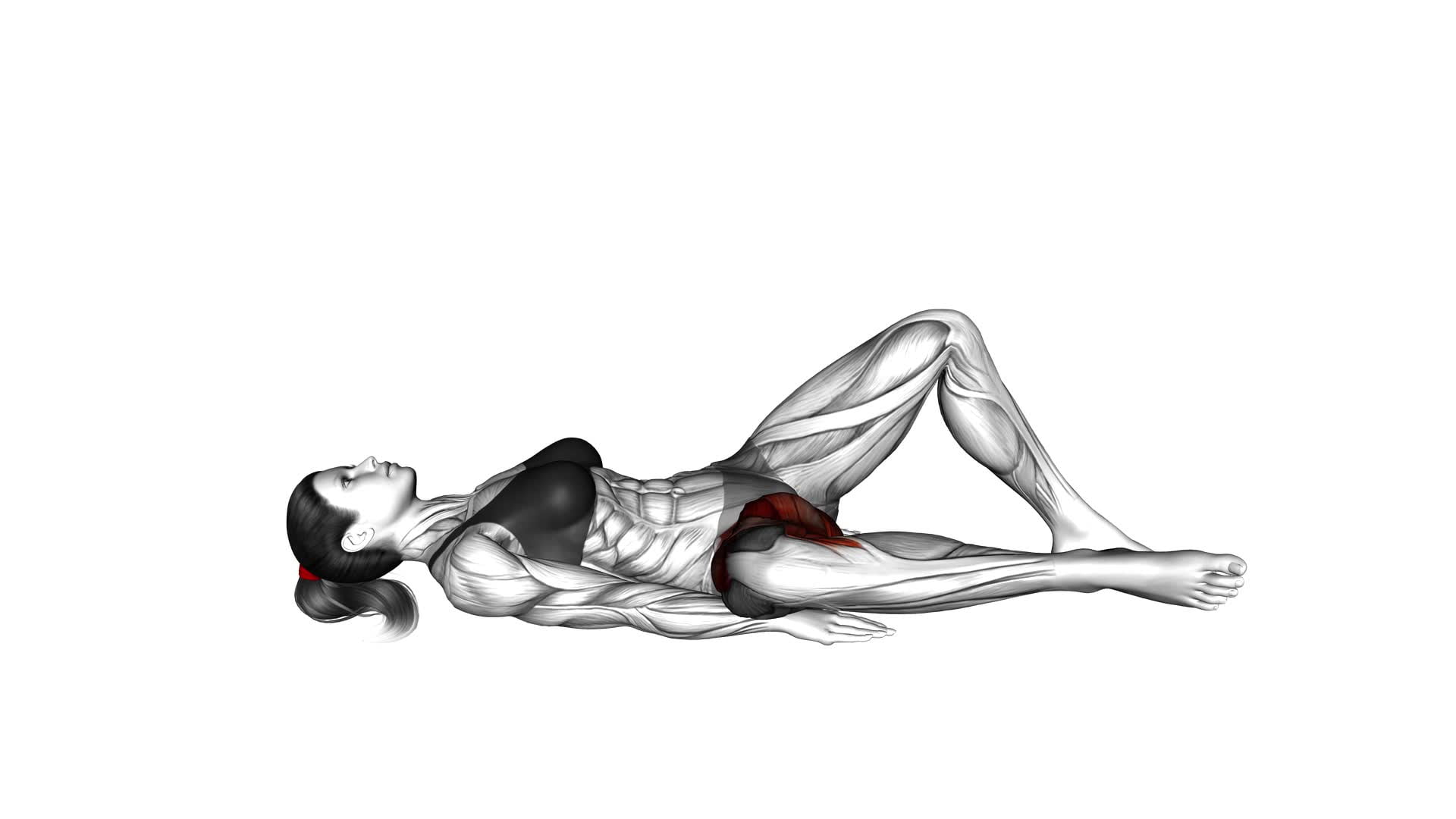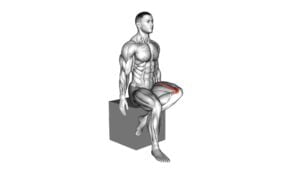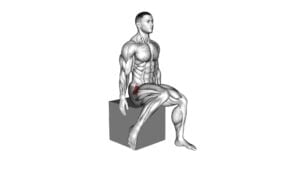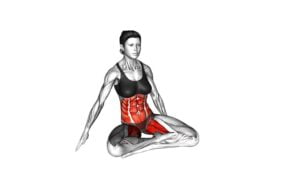Lying Hip Rotation (female) – Video Exercise Guide & Tips

Are you looking to strengthen your hips and improve flexibility?
Watch This Exercise Video
Look no further than the lying hip rotation exercise.
In this video exercise guide, we'll show you the proper form and technique to get the most out of this workout.
We'll also provide modifications and progressions, as well as common mistakes to avoid.
Follow our tips for maximizing results and get ready to feel the burn in your hips!
Key Takeaways
- Lying Hip Rotation (female) improves hip mobility, flexibility, and strength.
- It enhances overall athletic performance by targeting essential muscles for stability and power.
- Lying Hip Rotation (female) improves balance, coordination, and can give an edge in sports.
- Incorporating modifications and progressions like resistance bands, ankle weights, and unstable surfaces can increase the intensity and effectiveness of the exercise.
Benefits of Lying Hip Rotation (female)
Discover the numerous benefits of incorporating lying hip rotation (female) into your workout routine. Hip mobility is crucial for female athletes as it allows for better performance and reduces the risk of injuries. Lying hip rotation is an effective exercise that targets the hip muscles, helping to improve their flexibility and strength.
By incorporating lying hip rotation into your full body workout routine, you can enhance your overall athletic performance. This exercise specifically targets the hip abductor and external rotator muscles, which are essential for stability and power in movements such as running, jumping, and changing directions. Strengthening these muscles can also improve your balance and coordination, giving you an edge in your sport.
To incorporate lying hip rotation into your workout routine, start by lying on your side with your legs straight and stacked on top of each other. Bend your bottom knee for stability and place your top hand on your hip. Lift your top leg as high as comfortable, keeping it straight, and then rotate it forward and backward in a controlled motion. Perform 10-15 repetitions on each side.
Proper Form and Technique
To perform lying hip rotation (female) with proper form and technique, you should ensure that you're lying on your side with your legs straight and stacked on top of each other. This position helps to align your body correctly and maintain stability throughout the exercise. Proper form and technique are crucial not only for maximizing the benefits of the exercise but also for injury prevention.
When performing lying hip rotation, it's important to engage the correct muscles to achieve optimal muscle activation. Begin by keeping your core engaged and your hips stable. Slowly rotate your top leg upward, while keeping your feet together. Make sure to control the movement and avoid any jerking or swinging motions. As you rotate your leg, focus on feeling the activation in your glutes and outer hip muscles.
Maintaining proper form and technique throughout the exercise is essential for injury prevention. By keeping your body aligned and engaging the correct muscles, you reduce the risk of strain or injury to your hips, lower back, and knees. It's also important to avoid any excessive twisting or pressure on your joints.
If you experience any pain or discomfort, stop the exercise and consult with a healthcare professional. Remember, practicing proper form and technique is key to getting the most out of lying hip rotation (female) while minimizing the risk of injury. So, take your time, focus on maintaining stability and muscle activation, and enjoy the benefits of this effective exercise.
Modifications and Progressions
Try incorporating resistance bands or ankle weights to increase the intensity of the lying hip rotation exercise. These modifications can help you take your workout to the next level. Resistance bands are a great addition to this exercise as they provide constant tension throughout the movement, targeting your hip muscles even more. Simply place the band around your thighs and perform the exercise as usual. Ankle weights are another excellent option to add resistance. By strapping them around your ankles, you increase the load on your hip muscles, making them work harder.
If you're looking for advanced variations of the lying hip rotation exercise, you can try performing it on an unstable surface, such as a stability ball or a BOSU ball. This challenges your core stability and engages more muscles to maintain balance. Another option is to perform the exercise with your legs extended instead of bent. This increases the leverage and demands more strength from your hip muscles. Keep in mind that these variations require a strong foundation and proper form, so make sure you master the basic version before attempting them.
Common Mistakes to Avoid
To avoid common mistakes, make sure you maintain proper form and alignment while performing the lying hip rotation exercise. Proper form and alignment are crucial for maximizing the benefits of this exercise and preventing injuries.
One common mistake to avoid is rotating the hips too forcefully or quickly. This can put excessive strain on the hip joints and lead to injury. Instead, focus on controlled movements and gradually increase the range of motion as your hip mobility improves.
Another mistake to avoid is lifting the shoulders off the ground or arching the lower back. This can shift the focus away from the hips and put unnecessary strain on the spine. Keep your shoulders relaxed and your lower back flat against the ground throughout the exercise. Engage your core muscles to maintain stability and support your lower back.
Lastly, avoid using momentum to perform the exercise. The lying hip rotation is meant to be a controlled movement that targets the hip muscles. Using momentum can decrease the effectiveness of the exercise and increase the risk of injury. Take your time and focus on engaging the hip muscles throughout the movement.
By maintaining proper form and alignment, you can improve your hip mobility and reduce the risk of injury during the lying hip rotation exercise.
Now, let's move on to some tips for maximizing your results.
Tips for Maximizing Results
To further enhance your results, incorporate these key tips into your lying hip rotation exercise:
- Use effective stretching techniques: Before starting the lying hip rotation exercise, make sure to warm up properly. Perform dynamic stretches like leg swings or hip circles to loosen up your muscles and increase flexibility. This will help you to achieve a greater range of motion during the exercise and maximize its benefits.
- Maintain consistency in your workouts: Consistency is key when it comes to seeing results. Aim to perform the lying hip rotation exercise at least three times a week to reap its full benefits. By staying consistent, you allow your body to adapt and improve over time. Consistency also helps to prevent injuries and ensures that you progress towards your fitness goals.
Frequently Asked Questions
How Many Repetitions Should I Do for the Lying Hip Rotation Exercise?
To get the most out of the lying hip rotation exercise, it's important to know the proper form.
This exercise involves lying on your back with your knees bent and feet flat on the floor.
Keeping your core engaged, rotate your hips to one side and then the other, without lifting your shoulders off the ground.
As for repetitions, start with 10-12 on each side and gradually increase as you get stronger.
Adding lying hip rotation to your routine can improve hip mobility and strengthen your core muscles.
Can Lying Hip Rotation Help Reduce Lower Back Pain?
Lying hip rotation can be beneficial in reducing lower back pain. By engaging the muscles in your hips and lower back, this exercise can help improve your overall flexibility and strengthen the muscles that support your spine. To get the most out of this exercise, make sure to maintain proper form and technique. Focus on rotating your hips smoothly and controlled, without straining your lower back.
Incorporate this exercise into your routine for potential pain relief.
Is Lying Hip Rotation Suitable for Pregnant Women?
Lying hip rotation can be a great exercise for pregnant women looking for safe exercises during pregnancy. It helps to strengthen the hip muscles and improve flexibility, which can be beneficial during labor.
However, it's important to consult with your healthcare provider before starting any new exercise routine. They can provide guidance specific to your individual needs and ensure that the exercise is safe for you and your baby.
Can I Perform Lying Hip Rotation Exercise if I Have a Knee Injury?
If you have a knee injury, it's important to avoid exercises that put strain on your knees. Lying hip rotation may not be suitable for you in this case.
However, there are modifications you can make to reduce knee impact, such as using a cushion or pillow to support your knee.
It's also a good idea to consult with a healthcare professional for alternative exercises that are safe and won't aggravate your injury.
How Long Does It Take to See Results From Doing Lying Hip Rotation Exercises?
Incorporating lying hip rotation exercises into your daily routine can bring numerous benefits. It helps strengthen your hip muscles, improves flexibility, and enhances core stability.
To see maximum results, it's important to perform these exercises properly. Start by lying on your back with knees bent and feet flat on the ground. Then, rotate your knees to one side, keeping your shoulders on the ground. Hold for a few seconds and return to the starting position.
Consistency and correct form are key for noticeable results.
Conclusion
In conclusion, the lying hip rotation exercise is a beneficial workout for women. By maintaining proper form and technique, you can target and strengthen your hip muscles effectively.
Remember to start with modifications and progress gradually to avoid common mistakes.
By following these tips, you can maximize your results and achieve a stronger and more toned lower body.
Keep up the great work!

Author
Years ago, the spark of my life’s passion ignited in my mind the moment I stepped into the local gym for the first time. The inaugural bead of perspiration, the initial endeavor, the very first surge of endorphins, and a sense of pride that washed over me post-workout marked the beginning of my deep-seated interest in strength sports, fitness, and sports nutrition. This very curiosity blossomed rapidly into a profound fascination, propelling me to earn a Master’s degree in Physical Education from the Academy of Physical Education in Krakow, followed by a Sports Manager diploma from the Jagiellonian University. My journey of growth led me to gain more specialized qualifications, such as being a certified personal trainer with a focus on sports dietetics, a lifeguard, and an instructor for wellness and corrective gymnastics. Theoretical knowledge paired seamlessly with practical experience, reinforcing my belief that the transformation of individuals under my guidance was also a reflection of my personal growth. This belief holds true even today. Each day, I strive to push the boundaries and explore new realms. These realms gently elevate me to greater heights. The unique combination of passion for my field and the continuous quest for growth fuels my drive to break new ground.







